PUBLIC THINGS

|
PUBLIC THINGS, Toulouse, France 2000. Music
for PUBLIC THINGS by Anders Remmer.
|
 |
 |
 |
Introduction:
PUBLIC THINGS enable persons to use public space in various ways. The system consists of a number of functions which are accessible for anybody who wants to use them PUBLIC THINGS can be placed at different spots in public areas, such as streets, squares, public buildings, parks or roadsides. Anybody may take initiatives to expand PUBLIC THINGS with more functions.
Construction:
The initial system is constructed from polyethylene tanks The tanks hold most of the functions within a framework of acid resistant, stainless steel struts All materials are durable and weather proof The different elements can easily be reconfigured Foundation tanks filled with water add weight to the construction.
Maintenance:
PUBLIC THINGS are maintained by the persons using them.
System components:
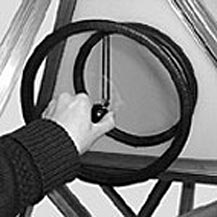 |
Dispenser: The dispenser is intended for the collection and distribution of different items: booklets, posters, food, and other types of objects. Anybody can fill the dispenser with items that they would like others to pick up, read or interact with. Components: Octahedron PE-tank, rubber strips, bakelite knob, elastic cord. |
 |
Public address device: This device enables persons to address each other in public. Speeches, information, stories, songs are uttered into the end of the transparent hose. The sound is amplified by the funnel. Components: PE-tank, PE funnel, PVC hose, rubber strips, bolts and nuts. |
 |
Lamp: The lamp uses 12 V and poses no security risk. It can run by 12 V AC or be connected to a solar power system. Components: PE-tank, 12 V / 9 W bulb, 220-12 V transformer, socket and electric cable. |
 |
Kitchen: The heat source for the kitchen is an alcohol burner surrounded by a triangular rest to hold pots and kettles. In order to cook, one must bring water, alcohol and food stuffs. Components: Alcohol burner, stainless acid resistant steel plates, rubber knee protectors, pots. |
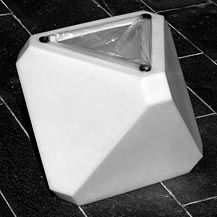 |
Toilet: A plastic bag is used to catch urine and faeces. Afterwards, the bag can be buried, composted or burnt. The end product of either one of these processes can be used as fertilizer. Components: PE-tank, PE-bag, rubber fixtures. |
 |
Bed: A place to rest or sleep is provided by a thin mattress. It is covered by plastic on all sides. An extra sheet of plastic can be folded over the resting person in order to protect against wind and rain. When not in use, the bed can be rolled up and fixed to the construction. Components: PE-foam, PVC sheet, rubber cord. |
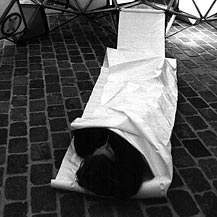 |
 |
Chair: Components: PE-tank, eyebolt, plastic coated steel wire. |
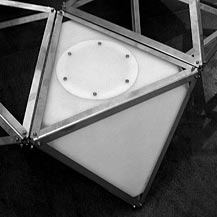 |
Foundation: The foundation tank adds weight to the construction This is done for two reasons: 1) The construction is balanced, 2) The construction is difficult to move. Components: PE-tank, PE-lid, screws. |
 |
Transformer: Output: 300 W, 12 V DC. |
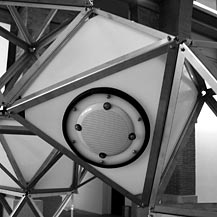 |
Sound: Water resistant loudspeakers are built into the tank. They are connected to sound equipment, which are placed in another module. Components: PE-tank, water resistant loudspeakers, cables, rubber strips, bolts and nuts. |
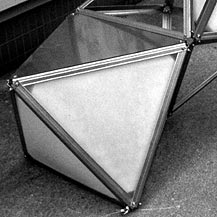 |
Table: Components: Stainless acid resistant steel plate, PE-tank, nuts and bolts. |
 |
Telescope: The telescope can be used to look at objects in the sky or on earth. Technical specifications: Model type: Reflector Focus length: F-600 m Mirror: 76 mm Ocular: 24.5 mm: 6 mm=100 x enlargement |
  |
Island with anchor: A number of tetrahedron PE-tanks and a framework of acid-resistant, stainless steel struts make up the floating island The island occupies water areas, expanding useable public space. The upper tanks can be filled with soil to allow seeds to germinate and grow The structure catches floating debris, branches and garbage, and in time it will grow to occupy more space. Three anchors hold the island in place. Components: 28 PE-tanks, stainless acid resistant steel struts, bolts and nuts, 3 anchors (PE-tanks, stones, chains). Dimensions: 2.5 m per side. |
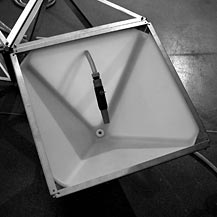 |
Wash basin: |
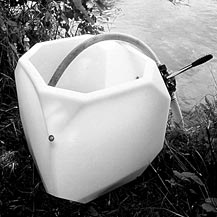 |
Bathtub: The bathtub is equipped with a manual pump. The water is pumped from the water source (e.g. a lake or sea) directly into the bathtub. The tank is emptied by swapping the tubes attached to the pump or by tilting the tank. Components: 60 cm cubic PE- tank, manual bilge pump, water hoses. |
 |
Shower: The shower consists of a black plastic tank. The hose in the top can be connected to a water source. The tank is filled with water when the water supply is turned on. The tank can also be filled through the top hole The water stays in the tank to heat in the sun, until the desired temperature is reached. Components: Black PE-tank, lid with bakelite knob and elastic cord, water hoses, fittings. |
PUBLIC THINGS situations
Back to manuals
Back to HOME